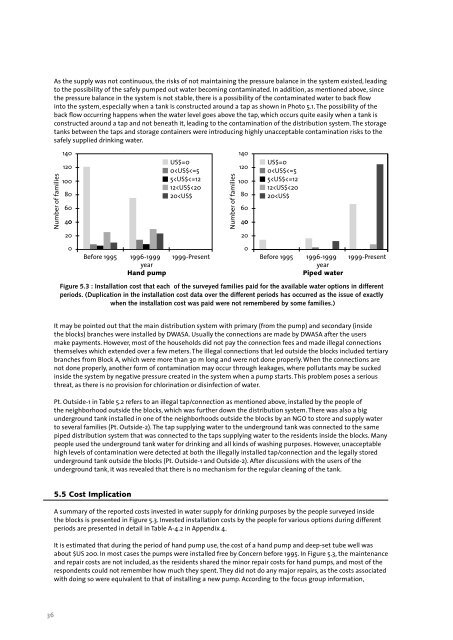Untitled - UNU-IAS - United Nations University
Untitled - UNU-IAS - United Nations University
Untitled - UNU-IAS - United Nations University
Create successful ePaper yourself
Turn your PDF publications into a flip-book with our unique Google optimized e-Paper software.
As the supply was not continuous, the risks of not maintaining the pressure balance in the system existed, leading<br />
to the possibility of the safely pumped out water becoming contaminated. In addition, as mentioned above, since<br />
the pressure balance in the system is not stable, there is a possibility of the contaminated water to back flow<br />
into the system, especially when a tank is constructed around a tap as shown in Photo 5.1. The possibility of the<br />
back flow occurring happens when the water level goes above the tap, which occurs quite easily when a tank is<br />
constructed around a tap and not beneath it, leading to the contamination of the distribution system. The storage<br />
tanks between the taps and storage containers were introducing highly unacceptable contamination risks to the<br />
safely supplied drinking water.<br />
<br />
<br />
<br />
<br />
<br />
<br />
<br />
<br />
<br />
<br />
<br />
<br />
<br />
<br />
<br />
<br />
<br />
<br />
<br />
<br />
<br />
<br />
<br />
<br />
<br />
<br />
<br />
<br />
<br />
<br />
<br />
<br />
<br />
<br />
<br />
<br />
<br />
<br />
<br />
<br />
<br />
<br />
<br />
<br />
<br />
<br />
<br />
<br />
It may be pointed out that the main distribution system with primary (from the pump) and secondary (inside<br />
the blocks) branches were installed by DWASA. Usually the connections are made by DWASA after the users<br />
make payments. However, most of the households did not pay the connection fees and made illegal connections<br />
themselves which extended over a few meters. The illegal connections that led outside the blocks included tertiary<br />
branches from Block A, which were more than 30 m long and were not done properly. When the connections are<br />
not done properly, another form of contamination may occur through leakages, where pollutants may be sucked<br />
inside the system by negative pressure created in the system when a pump starts. This problem poses a serious<br />
threat, as there is no provision for chlorination or disinfection of water.<br />
Pt. Outside-1 in Table 5.2 refers to an illegal tap/connection as mentioned above, installed by the people of<br />
the neighborhood outside the blocks, which was further down the distribution system. There was also a big<br />
underground tank installed in one of the neighborhoods outside the blocks by an NGO to store and supply water<br />
to several families (Pt. Outside-2). The tap supplying water to the underground tank was connected to the same<br />
piped distribution system that was connected to the taps supplying water to the residents inside the blocks. Many<br />
people used the underground tank water for drinking and all kinds of washing purposes. However, unacceptable<br />
high levels of contamination were detected at both the illegally installed tap/connection and the legally stored<br />
underground tank outside the blocks (Pt. Outside-1 and Outside-2). After discussions with the users of the<br />
underground tank, it was revealed that there is no mechanism for the regular cleaning of the tank.<br />
5.5 Cost Implication<br />
A summary of the reported costs invested in water supply for drinking purposes by the people surveyed inside<br />
the blocks is presented in Figure 5.3. Invested installation costs by the people for various options during different<br />
periods are presented in detail in Table A-4.2 in Appendix 4.<br />
It is estimated that during the period of hand pump use, the cost of a hand pump and deep-set tube well was<br />
about $US 200. In most cases the pumps were installed free by Concern before 1995. In Figure 5.3, the maintenance<br />
and repair costs are not included, as the residents shared the minor repair costs for hand pumps, and most of the<br />
respondents could not remember how much they spent. They did not do any major repairs, as the costs associated<br />
with doing so were equivalent to that of installing a new pump. According to the focus group information,<br />
36
















